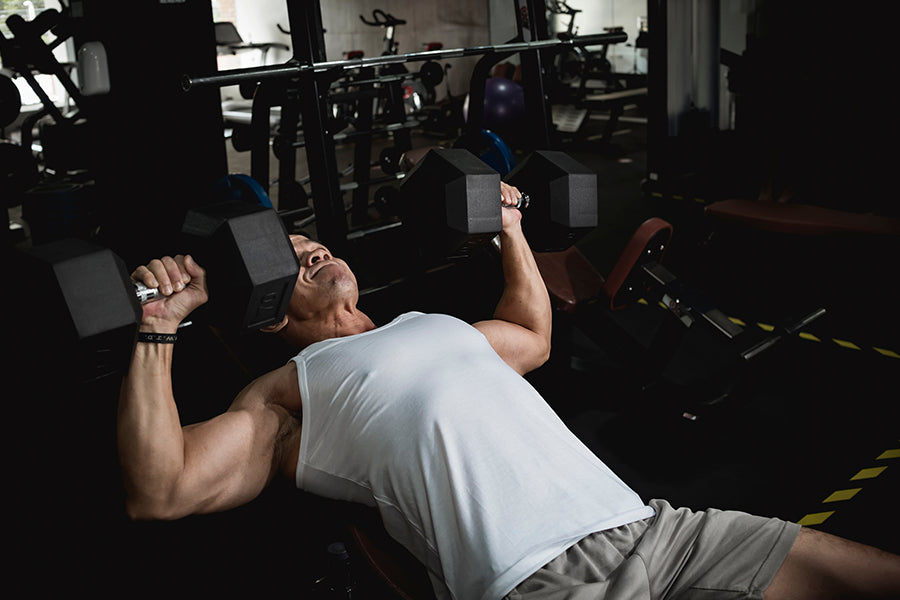If you're looking to get seriously strong, the bench press is a critical player in your training. Working out all of the big three — pecs, triceps, and shoulders — and hitting those imbalances with added core activation when using dumbbells ticks all boxes.
Replacing the barbell with a pair of dumbbells while performing bench press increases instability, activating muscles around your core. With greater muscle activation comes improved balance and coordination to reduce any imbalances.
Ready to give this strength exercise a go? Follow our guide for perfecting form and reap the rewards.
What is a Dumbbell Bench Press?
A variation of the standard barbell bench press, the dumbbell bench press is an exercise that focuses on developing the chest muscles. Other names for this exercise include the dumbbell flat bench press and the dumbbell chest press.
The dumbbell bench press is an upper-body workout that works the muscles in your chest, arms, and shoulders.
After a certain threshold of strength has been reached with the barbell bench press, the dumbbell bench press is frequently recommended as a safer alternative to prevent injuries to the pecs and shoulders.
Start with a weight that you can control for 2-3 sets of 8–12 repetitions when performing dumbbell bench presses. Pick a weight that enables you to continue using proper form for all sets and repetitions.
- Grab a pair of dumbbells, then sit on the bench with the weights in your hip crease. While holding the dumbbells on your hips, recline back on the bench.
- Once you're in position, tighten your abdominal muscles and raise the dumbbells to your chest. You should have your palms pointing forward. Your upper back should continue to be stable and tight. This starting position should be used for all repetitions.
- Slowly lower the dumbbells until your upper arms are parallel to your back while keeping a neutral wrist. Your upper and lower arms should make a 90-degree angle, and your elbows should be placed 45 degrees from your torso. At the bottom of the movement, pause.
- Squeeze your chest and push the dumbbells back to the beginning position to start the upward movement. Keep pressing until your arms are extended, and your elbows are slightly bent.
- Squeezing your chest at the top will bring the movement to a close. After the exercise, keep your space between the dumbbells.
Muscles Worked By the Dumbbell Bench Press
Dumbbell bench presses are great for building aesthetically pleasing and functional upper-body muscle mass and strength. The key muscles used in a dumbbell bench press are listed below.
Pectorals
When it comes to producing the necessary amount of force for the dumbbell bench press, the key muscle groups involved are the pectoral muscles. When using dumbbells, you'll be able to move through deeper ranges of motion during the eccentric portion of the movement. Higher chest engagement means more gains.
Triceps
The triceps are responsible for the ultimate extension of the elbow, which is necessary to lock out the bench press. They are also crucial in the stabilization of the elbow. You can better isolate your triceps by completing exercises such as the close-grip bench press, for which you can adjust the width and style of your bench press grip.
Deltoids
With the deltoids at work, the ball-and-socket shoulder joint can be moved in any direction, allowing for a greater range of motion. Since bench pressing requires a fully extended arm position, this is crucial. Shoulders work to support the shoulder joint and help with the press, while the triceps and chest handle the bulk of the work.
Related Article: What are Deltoid Muscles? 6 Best Shoulder Isolation Exercises for Men to Get Bigger Deltoids
Benefits of the Dumbbell Bench Press
Despite its reputation as an exercise, the bench press is an excellent way to build upper-body strength and mass, useful for any form of weightlifting. The benefits of the dumbbell bench press are listed below.
Builds Muscle and Strength
Strength and muscle growth are two benefits that can be achieved by bench pressing. Almost every lifter could improve their performance in their chosen sport if they were stronger and bulkier. The bench press and overhead movements are essential to building up your upper body pushing strength.
Possibility of More Variations
Dumbbells provide a more versatile grip than barbells, which lock your joints into one position. At a certain degree of elbow rotation, some weightlifters may feel discomfort (which is dictated by hand position).
Flared elbows during a conventional barbell bench press can strain the shoulder joint. Doing the dumbbell bench press with a neutral grip is easier on the joints. By doing so, the angle formed by the wrist and the shoulder joint will be closer to that of a human's natural anatomy, making movement easier and more pleasant. To put it simply, a barbell will not suffice here.
Increased Unilateral Strength
There is a more powerful aspect to every person. It's human nature to favor one arm and one shoulder. One side of the body commonly exerts more force than the other when lifting a barbell. With dumbbells, though, you can train unilaterally.
You'll give your chest, shoulders, and triceps on one side a chance to recover while working out on the other. Your newfound strength on that side will also benefit you when performing barbell exercises.
Improved Range of Motion
As opposed to a barbell bench press, dumbbells allow you to lower the weights without touching your chest. This means that you will put more strain on your shoulder joints and stretch your muscles more, leading to increased muscle size and strength.
The shoulder wants to move, so if you can increase its range of motion, you'll end up with stronger, more resilient shoulders.
Related Article: 25 Most Effective Stretches to Do Before Exercising
Dumbbell Bench Press Variations
The following is a list of a few different versions of the dumbbell bench press that can be used by both coaches and players to keep their training diverse and to progress.
Dumbbell Floor Press

The dumbbell floor press is a version of the dumbbell bench press that is performed by lying flat on one's back on the floor rather than on a bench. Doing this limits the pressing movement's whole range of motion, which puts more strain on the triceps to help in the lockout position.
It can also aid in developing a deeper comprehension of how to support your upper back.
- Start by sitting upright on the floor with your legs extended and the dumbbells balanced vertically on the ground.
- With a tight grip, pick up each dumbbell and place it high in your hip crease.
- Slowly recline, keeping the dumbbells close to your chest. Bend your knees to around a 45-degree angle. Slightly raise your feet.
- Your triceps and chest should be contracted to extend the weights fully.
- Bring the weight down slowly until your elbows touch the floor, then press it back up again.
Incline Press

You can improve your upper chest by pressing dumbbells or barbells on an incline press, which forces a slightly broader range of motion and can help you build muscle.
- Start in the same position as a standard dumbbell bench press; just make sure the bench is inclined at an angle of 30 to 45 degrees.
- Perform the exercise you would typically perform, a bench press.
- Repeat
Single-Arm Dumbbell Bench Press

During the bench press movement, if one dumbbell is used for the single-arm dumbbell bench press instead of both dumbbells, the variation is called the single-arm dumbbell bench press.
- Lay down on a level bench and grasp a dumbbell in one hand. Extend the arm to be completely straight, and ensure the weight is in line with your shoulder.
- Bend your arm gradually and reduce the weight towards the side of your chest as you do so.
- After that, you should extend back to the starting location.
- Repeat on the other side.
Besides providing a boost to core and glute activation during the bench press, this variant also provides athletes with the benefit of unilateral stability and strength. Additionally, the core muscles will be engaged as they fight to keep the torso from twisting too much to one side.
FAQs
1. What weight should I use?
Your weight for your Dumbbell Bench Press will depend mainly on your goals. If you’re looking to build mass and muscle, increase the weight you use as you become more comfortable performing the exercise. It’s essential to challenge yourself and keep pushing the limit - it can be difficult to make significant gains when using a weight that is far too easy.
However, it's equally important not to overdo it, as this can lead to injury. Start with a lower weight that allows you to complete 8-12 reps in good form and technique before adding more sets or increasing the weight.
Make sure your range of motion and form is correct throughout each set. Don't feel bad if you need to reduce the weights once fatigue sets in - quality is just as important as quantity when it comes to results!
2. How much time should I rest between sets?
Resting between sets for Dumbbell Bench Press is essential to allowing your muscles to recover and build strength. The amount of rest will depend on the difficulty and weight level you are using.
Generally, if you are beginning a routine or using lighter weights, rest periods can be 30-90 seconds between sets. More experienced lifters tackling heavier weights should increase their rest times up to 2-3 minutes to give their muscles enough time to recuperate before attempting another set.
It is essential not to let your muscles become overly fatigued, as this puts them at risk of injury. Therefore, an appropriate amount of rest time will provide ample recovery for all muscle groups involved in the workout environment.
3. Which hand position is more effective for targeting specific parts of my chest?
If you're looking to add Dumbbell Bench Presses to your chest workouts, choosing the right grip can make a big difference. Targeting certain parts of the chest this way requires an understanding of both wide-grip and close-grip variations of the exercise.
A wide grip moves more tension/stretch onto your chest muscles and is best done with your hands a bit farther apart than shoulder width. The close grip focuses more on the tricep muscles and is typically done with hands in a neutral position and your elbows close to your body. Lastly, your hands are on a slight diagonal with your elbows at 45 degrees you will get an even stretch and contraction along the chest and triceps.
Whichever grip you choose, ensure you don't overdo it and leave yourself prone to injury. Make sure your form is correct and practice proper lifting techniques for each exercise to maximize your results and minimize any injuries that could occur from incorrect forms.
Take Away
Whether you want to build muscle, improve your overall strength and stability or put on some serious mass, the dumbbell bench press should become a staple part of your workout routine. It's essential always to have a risk versus gain assessment and to make a decision that will positively benefit you.
So, there you have everything you need to know about the dumbbell bench press. Next time you're in the gym, grab some dumbbells and start doing this exercise. Once you have relaxed into a comfortable position, get pushing and watch that weight go up. Give it a try, and you will be making some serious gains in no time.











